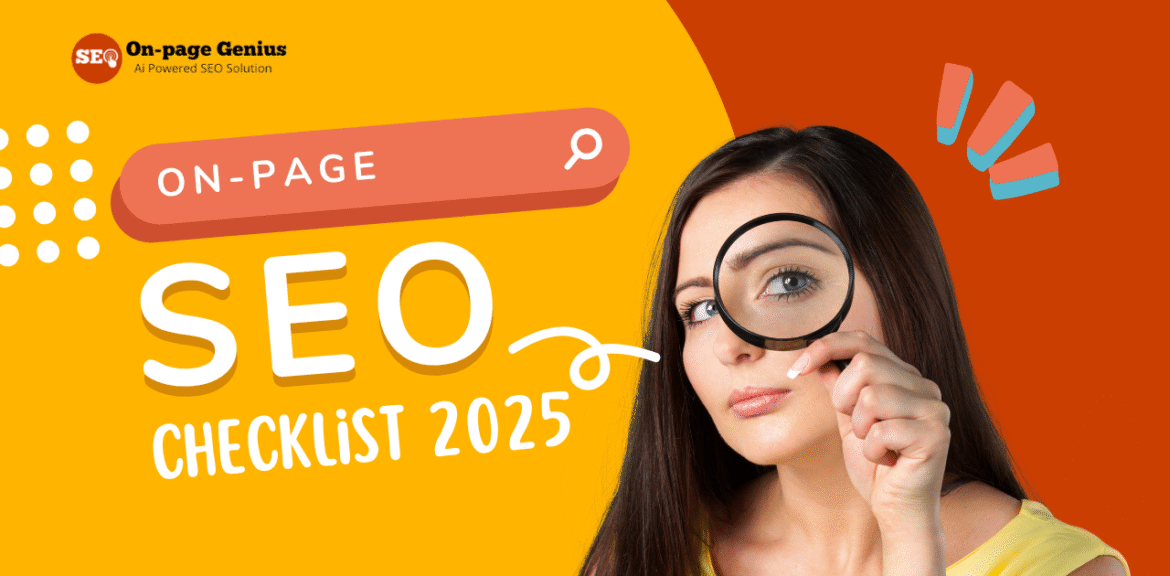
If you’re aiming to dominate search results in 2025, mastering on-page SEO is non-negotiable. With evolving algorithms and AI-driven updates, optimizing your website content, structure, and performance using artificial intelligence tools is essential. This guide covers a complete, updated on-page SEO checklist that leverages AI-powered techniques to boost your rankings, enhance user experience, and drive targeted traffic to your website.
Overview :
- Keyword Optimization
- Meta Tags and Headings
- Technical SEO Improvements
- User Experience and Accessibility
- Poll: Your SEO Challenge
- Conclusion
Keyword Optimization
1. Use Targeted Keywords Smartly
- Use AI keyword research tools to uncover long-tail and intent-based keywords.
- Place primary keywords in the title, H1, first 100 words, and conclusion.
- Use LSI (Latent Semantic Indexing) keywords and synonyms identified through machine learning.
Meta Tags and Headings
2. Craft Compelling Meta Tags
- Keep your meta title under 58 characters.
- Write click-worthy meta descriptions under 155 characters.
- Include your main keyword in both.
- Use AI tools to generate and test variations for better CTR.
3. Optimize Headings & Subheadings
- Use proper H1, H2, and H3 structure.
- Add keywords naturally in subheadings.
- Break content into scannable sections using AI-based content structuring tools.
Technical SEO Improvements
4. Improve URL Structure
- Use clean, short, keyword-rich URLs.
- Avoid stop words and unnecessary parameters.
- Example: yoursite.com/on-page-seo-checklist
5. Write High-Quality, Valuable Content
- Use AI-assisted writing tools to maintain clarity and consistency.
- Focus on solving user intent.
- Use a conversational tone and provide original insights.
- Aim for at least 1000+ words per core page.
6. Optimize Images with SEO
- Use descriptive filenames and AI-generated alt tags.
- Compress images for faster loading.
- Implement next-gen formats like WebP.
7. Add Internal & External Links
- Link to relevant internal pages with proper anchor text.
- Use AI to identify relevant linking opportunities.
- Add outbound links to credible sources.
- Avoid broken links.
8. Enhance Page Speed & Core Web Vitals
- Use tools like PageSpeed Insights and AI-based speed analysis tools.
- Minimize CSS/JS, leverage browser caching.
- Aim for LCP <2.5s, FID <100ms, CLS <0.1.
User Experience and Accessibility
9. Make It Mobile-Friendly
- Use responsive design.
- Test using Google’s Mobile-Friendly Test.
- Use AI to predict and improve mobile user behavior.
- Ensure buttons and text are easily clickable.
10. Add Structured Data (Schema Markup)
- Implement schema for articles, products, reviews, etc.
- Use JSON-LD format.
- Use AI tools to detect missing schema opportunities.
- Help search engines better understand your content.
11. Improve User Engagement Signals
- Use clear CTAs, videos, and FAQs.
- Use AI-powered heatmaps and analytics to enhance layout.
- Lower bounce rate with engaging visuals and layout.
- Encourage comments and interaction.
12. Optimize for Voice & AI Search
- Use natural, question-based queries.
- Add an FAQ section with conversational answers.
- Use schema to support featured snippets.
- Leverage AI to anticipate voice search trends and user queries.
Quick Poll: What’s Your Biggest On-Page SEO Challenge?
Conclusion:
On-page SEO is the foundation of your search visibility. Therefore, by following this AI-enhanced, 2025-ready checklist, you’re not just optimizing for search engines—you’re building a better experience for your users. Moreover, staying updated and testing regularly will give you a competitive edge. Always prioritize value over volume.
Need a full SEO audit? Try our free AI-powered tool at OnPageGenius.com and uncover what your site really needs to rank higher.
Get Free SEO Audit
